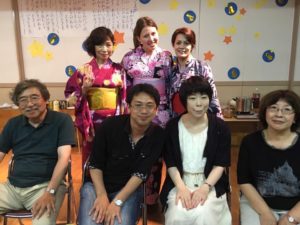One emerging trend in modern Japanese culture is the concept of animal “cafes”. These are little shops that let you pay by the hour to play with a particular type of animal – the various cafes include all kinds, ranging from cats to owls! Originally created Tokyo, where it is difficult for many residents to own their own pets, these animal cafes have spread all over Japan, and I had the opportunity to visit a couple of them and experience this neat piece of Japanese culture for myself. These cafes fit right in with Japanese Kawaii culture! It was a lot of fun – I wish they had some of these back in the US!
Above I am visiting a dog cafe, which consisted of a large room full of poodles, beagles, and a golden retriever! The customer just sits down on the floor, and dogs come running over looking for pets. The dogs love the attention, the people love the dogs, and it seems like a win-win set-up! They only allow a certain number of people in the room at once, of course, and the line was far out the door. Turns out this is really popular!

Next was the rabbit cafe! In a room full of the most adorable rabbits I had ever seen, you could sit on a stool and pet a rabbit in your lap, switching rabbits every 10 minutes. Another great idea for a business!! I wouldn’t want the responsibility of owning a rabbit, but being able to play with them for an hour was a lot of fun. I can see why the Japanese really like their animal cafes!
Finally, another great cultural experience I had was the kickoff to the annual Hakodate Port Festival, which was a brilliant fireworks display. Summer festivals are a big deal in northern Japan, where the winters are long, and generally the whole town becomes involved somehow, whether it be in the parade, selling festival food, or visiting the street stands and the events. Most people wear Yukatas (summer kimonos) to festivals, and I got to wear mine and be a part of the fun. The fireworks were spectacular – I learned Japanese firework shows are always long, dramatic, and impressive, and this one was no exception! The following day I walked through the street stands observing the festival food – including colored chocolate-covered bananas on sticks, shaved frozen fruit (frozen fruit through a shave ice machine – amazing!) and yakisoba (a fried noodle dish). There was a also a huge parade (with 10,000 people in it!) featuring lots of squid dancing – Hakodate’s signature dance. This was an amazing experience for the last week of my stay in Hakodate. I hope that someday I have reason to wear my Yukata to a festival again!





